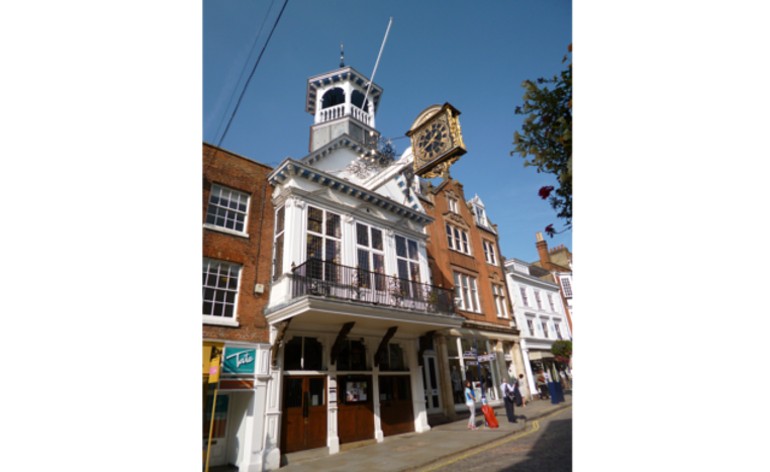Guildford Guildhall was constructed circa 1550 and was formerly used as a courtroom before the Council Chamber was added in 1683 along with the shimmering clock. It is for this reason that it is a highly recognisable feature of Guildford’s High Street and now it acts as a tourist attraction and symbol of the town altogether.
The Guildhall is a Grade I listed building and is also where the Mayor and Guildford Corporation met to regulate the commerce of the Borough in the upstairs Council Chamber until 1931, and where the various courts of law sat in judgement.
The building is predominantly Elizabethan, although it is thought to stand on the site of a pre-existing Medieval Guildhall which is known to have been in place in the 1300s. The Council Chamber with balcony overlooking the street and bell tower above was added in 1683 when the building was refurbished, and the clock was presented to the Corporation by a London clockmaker (John Aylwark) who struck a deal with them in order to have freedom of trade in the borough.
Elizabeth’s Coat of Arms was inserted in the stained glass window above the judge’s bench after one of her visits in 1589, which also was the catalyst for the extension at the north of the building. The Arms of the Borough itself were added later along with those of Anne of Denmark who was James I’s queen. There are also beautiful paintings of Charles II, James II and William and Mary, and one of the colour party of the Queen’s Regiment commemorating the presentation of the Freedom of the Borough in 1946.
The ground floor is of Tudor origin and houses the Civic plate as well as many rare items such as a 16th century two-handed sword which hangs over the bench. This decorative item is then carried in front of the Mayor during an annual procession; a traditional that has occurred since 1922.
Fine wood panelling can be found upstairs in the Council Chamber and a carved chalk fireplace which is most likely to have come from the nearby demolished (at the end of the 1600s) Stoughton Manor House. The paintings include a portrait of Admiral Sir Richard Onslow after his victory at Camperdown, painted by John Russell RA, whose father was four times Mayor of Guildford.
The pride of the Guildhall is the Borough Plate, a collection of beautiful silver which includes pieces which form the insignia of municipal authority and items used in connection with banquets and other functions.
The Mayor has a campeachy or logwood Staff (which is said to have been presented by Queen Elizabeth) which bears the date of 1565 and the castle, which also figures in Guildford’s Coat of Arms. The Mayor’s golden Badge and Chain date back to 1673 and the Mayoress has matching gold badges with silver for other dignitaries.
With two rooms available for hire, the Guildhall can accommodate events ranging from small meetings to private functions and wedding receptions for up to 100 guests. The Guildhall is open Tuesdays and Thursdays to the public and the town guides lead tours which are free of charge with no booking necessary, simply turn up at the designated times and a guide will take you on a tour around the historic building. Group tours are also available by prior arrangement.
Ade Lawal


